Middleton W.M. (ed.) Reference Data for Engineers: Radio, Electronics, Computer and Communications
Подождите немного. Документ загружается.

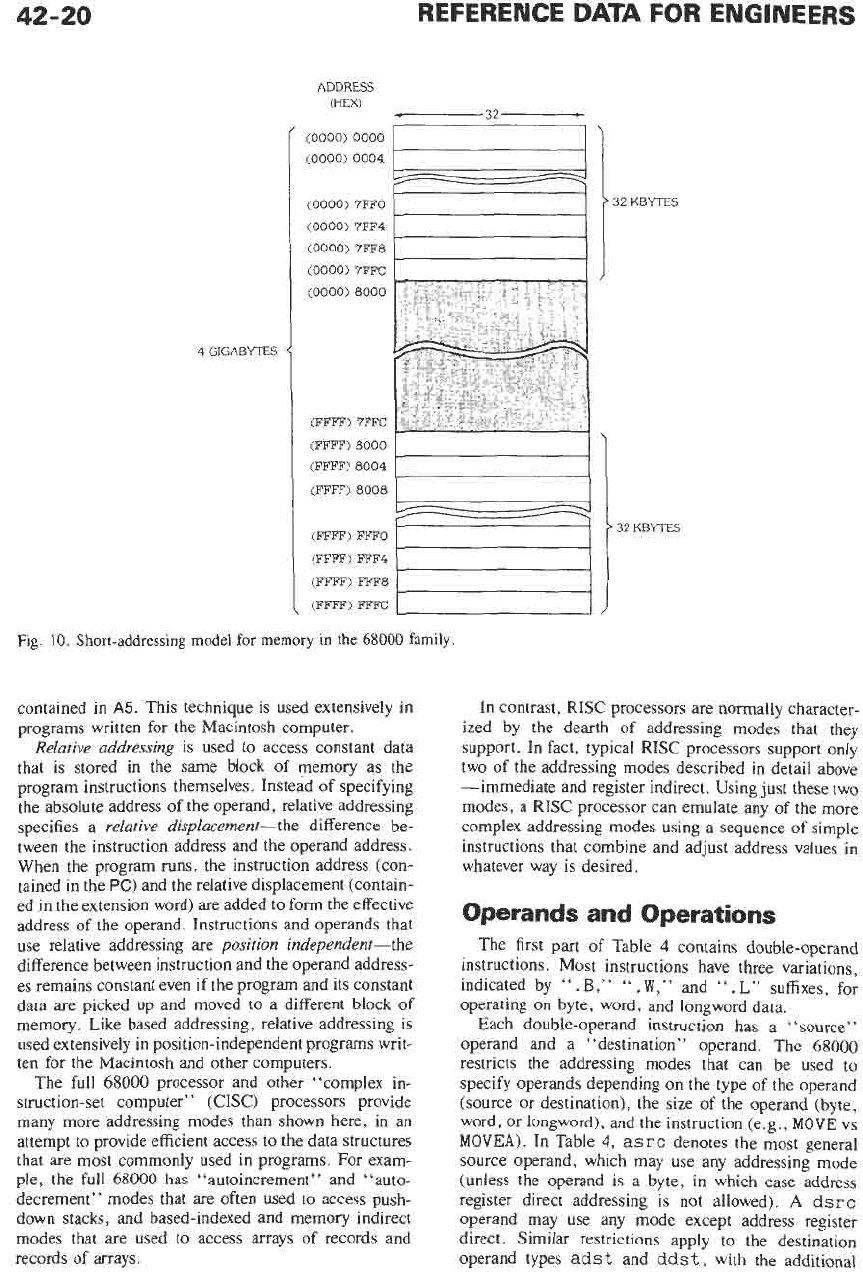
42-20
REFERENCE
DATA
FOR
ENGINEERS
4
GIGABYTES
ADDRESS
(HEX)
(0000)
0000
(0000)
0004
(0000)
7FF0
(0000)
7FF4
(0000)
7FF8
0000
7FFC
0000
8000
.FFFF‘ 7FFC
(FFFF) 8000
(FFFF)
8004
(FFFF) 8008
(FFFF) FFFO
(FFFF) FFF4
(FFFF) FFFS
(FFFF) FFFC
Fig.
10.
Short-addressing model for memory in the
68000
family.
contained in
A5
This technique is used extensively in
programs written for the Macintosh computer.
Relative addressing is used to access constant data
that is stored in the same block
of
memory as the
program instructions themselves, Instead of specifying
the absolute address of the operand, relative addressing
specifies a relarive displacement-the difference be-
tween the instruction address and the operand address.
When the program runs, the instruction address (con-
tained in the
PC)
and the relative displacement (contain-
ed in the extension word) are added to form the effective
address of the operand. Instructions and operands that
use relative addressing are position independent-the
difference between instruction and the operand address-
es remains constant even if the program and its constant
data are picked up and moved to
a
different block
of
memory. Like based addressing, relative addressing is
used extensively in position-independent programs writ-
ten for the Macintosh and other computers.
The full
68000
processor and other “complex in-
struction-set computer” (CISC) processors provide
many more addressing modes than shown here, in an
attempt to provide efficient access to the data structures
that are most commonly used in programs. For exam-
ple, the
full
68000
has “autoincrement” and “auto-
decrement” modes that are often used to access push-
down stacks, and based-indexed and memory indirect
modes that are used to access arrays of records and
records of arrays.
’
32
KBYTES
32
KBYTES
In contrast, RISC processors are normally character-
ized by the dearth of addressing modes that they
support. In fact, typical RISC processors support only
two of the addressing modes described in detail above
-immediate and register indirect. Using just these two
modes, a RISC processor can emulate any of the more
complex addressing modes using a sequence of simple
instructions that combine and adjust address values in
whatever way
is
desired.
Operands
and
Operations
The first
part
of Table
4
contains double-operand
instructions. Most instructions have three variations,
indicated by
“.B,”
“.W,”
and
“.L”
suffixes, for
operating on byte, word, and longword data.
Each double-operand instruction has a “source”
operand and a “destination” operand. The
68000
restricts the addressing modes that can be used to
specify operands depending on the type of the operand
(source or destination), the size of the operand (byte,
word, or longword), and the instruction (e.g., MOVE vs
MOVEA). In Table
4,
asrc
denotes the most general
source operand, which may use any addressing mode
(unless the operand is a byte, in which case address
register direct addressing is not allowed).
A
dsrc
operand may use any mode except address register
direct. Similar restrictions apply to the destination
operand types
adst
and
ddst,
with the additional
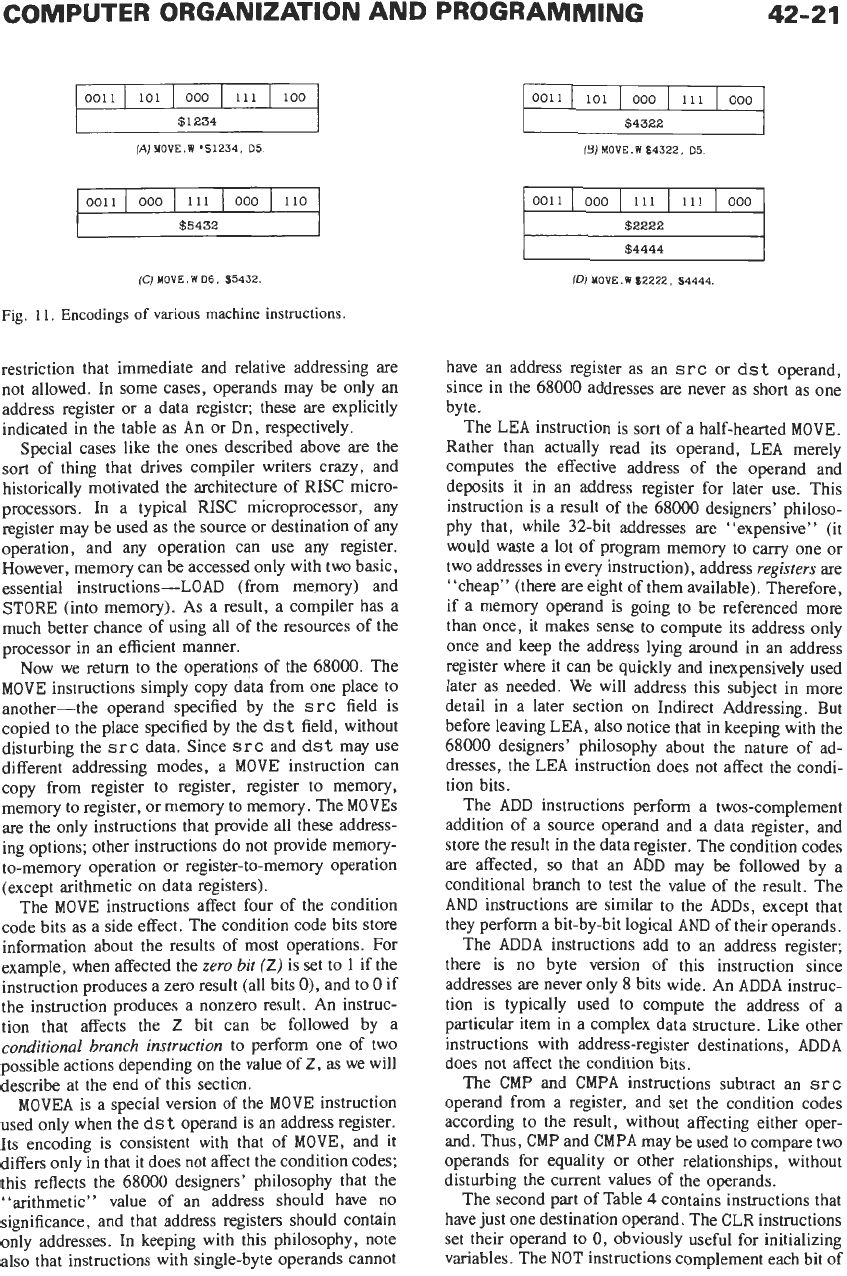
42-21
~
0011
101
000
111
100
$1234
0011
000
111
000
(AjM0VE.W
‘$1234.
D5
110
IO011
I
101
I
000
1
111
I
000
1
$4322
(5)
MOVE.
W
$4322, D5.
IO011
1
000
I
111
I
111
I
000
I
I
$2222
I
(C)
MOVE.
W
D6,
$5432
Fig.
11,
Encodings
of
various
machine instructions.
$4444
(0)
MOVE.
W
$2222, $4444
restriction that immediate and relative addressing
are
not allowed. In some cases, operands may be only an
address register or a data register; these are explicitly
indicated in the table as An or Dn, respectively.
Special cases like the ones described above
are
the
sort of thing that drives compiler writers crazy, and
historically motivated the architecture of RISC micro-
processors. In a typical RISC microprocessor, any
register may be used as the source or destination of any
operation, and any operation can use any register.
However, memory can be accessed only with two basic,
essential instructions-LOAD (from memory) and
STORE (into memory). As a result, a compiler has a
much better chance of using all of the resources of the
processor in an efficient manner.
Now we return to the operations of the 68000. The
MOVE instructions simply copy data from one place to
another-the operand specified by the
src
field is
copied to the place specified by the
dst
field, without
disturbing the
src
data. Since
src
and
dst
may use
different addressing modes, a
MOVE
instruction can
copy from register to register, register to memory,
memory to register, or memory to memory. The MOVES
are the only instructions that provide all these address-
ing options; other instructions do not provide memory-
to-memory operation or register-to-memory operation
(except arithmetic on data registers).
The MOVE instructions affect four of the condition
code bits as a side effect. The condition code bits store
information about the results of most operations. For
example, when affected the
zero bit
(Z)
is set to
1
if the
instruction produces a zero result (all bits
0),
and to
0
if
the instruction produces a nonzero result. An instruc-
tion that affects the
2
bit can be followed by a
conditional branch instruction
to perform one of two
possible actions depending on the value of
2,
as we will
describe at the end of this section.
MOVEA is a special version of the MOVE instruction
used only when the
ds
t
operand is an address register.
Its encoding is consistent with that of MOVE, and it
differs only in that it does not affect the condition codes;
this reflects the 68000 designers’ philosophy that the
“arithmetic” value of an address should have
no
significance, and that address registers should contain
only addresses. In keeping with this philosophy, note
also that instructions with single-byte operands cannot
have an address register as an
src
or
dst
operand,
since in the 68000 addresses are never as short as one
byte.
The LEA instruction is sort of a half-hearted MOVE.
Rather than actually read its operand, LEA merely
computes the effective address
of
the operand and
deposits it in an address register for later use. This
instruction is a result of the 68000 designers’ philoso-
phy that, while 32-bit addresses are “expensive” (it
would waste a lot of program memory to carry one or
two addresses in every instruction), address
registers
are
“cheap” (there are eight of them available). Therefore,
if a memory operand is going to be referenced more
than once, it makes sense to compute its address only
once and keep the address lying around in an address
register where it can be quickly and inexpensively used
later as needed. We will address this subject in more
detail in a later section on Indirect Addressing. But
before leaving LEA, also notice that in keeping with the
68000 designers’ philosophy about the nature of ad-
dresses, the LEA instruction does not affect the condi-
tion bits.
The
ADD
instructions perform a twos-complement
addition
of
a source operand and a data register, and
store the result in the data register. The condition codes
are affected,
so
that an
ADD
may be followed by a
conditional branch to test the value of the result. The
AND
instructions are similar to the
ADDS,
except that
they perform a bit-by-bit logical
AND
of their operands.
The
ADDA
instructions add to an address register;
there is no byte version of this instruction since
addresses are never only 8 bits wide. An
ADDA
instruc-
tion is typically used to compute the address of a
particular item in a complex data structure. Like other
instructions with address-register destinations,
ADDA
does not affect the condition bits.
The CMP and CMPA instructions subtract an
src
operand from a register, and set the condition codes
according to the result, without affecting either oper-
and. Thus, CMP and CMPA may be used to compare two
operands for equality or other relationships, without
disturbing the current values of the operands.
The second part
of
Table
4
contains instructions that
have just one destination operand. The CLR instructions
set their operand to
0,
obviously useful for initializing
variables. The NOT instructions complement each bit of
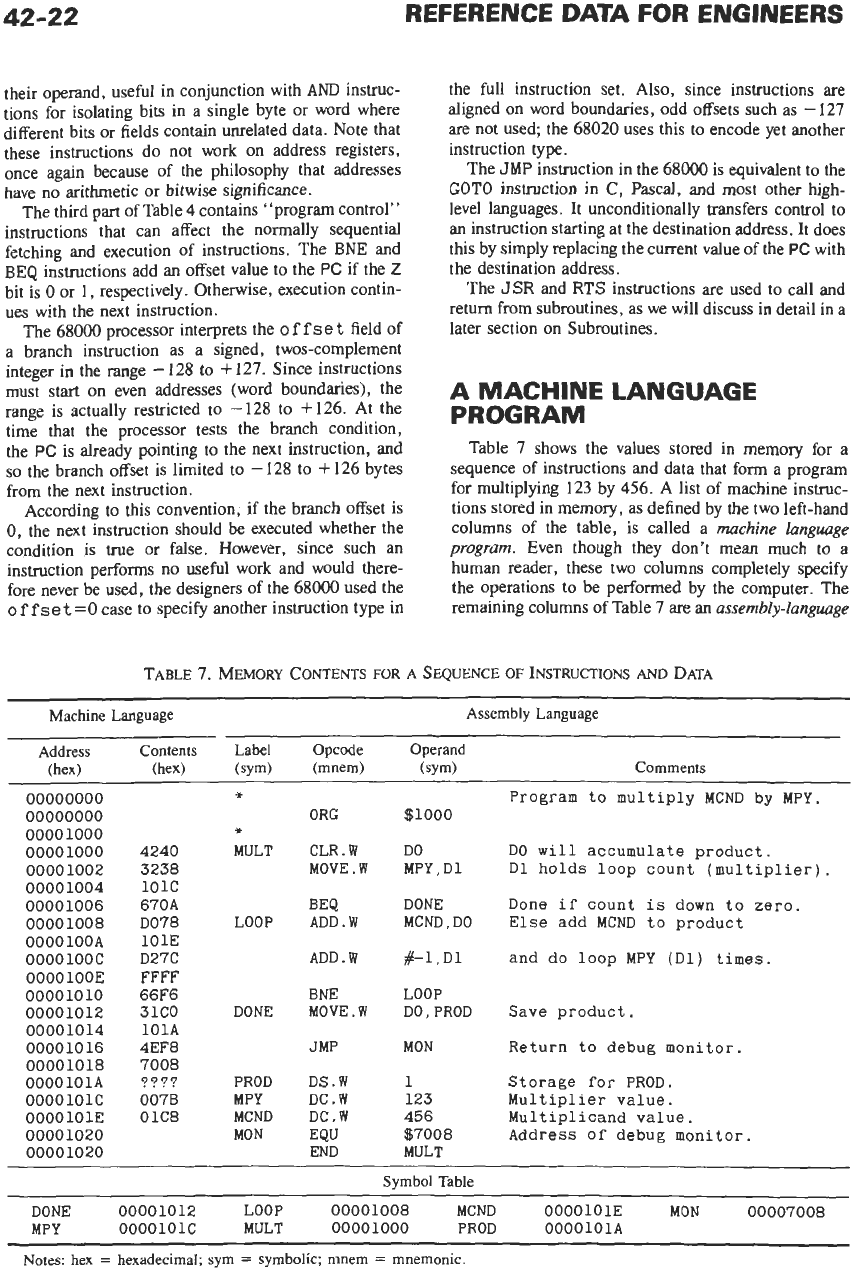
their operand, useful in conjunction with
AND
instruc-
tions for isolating bits in a single byte or word where
different bits or fields contain unrelated data. Note that
these instructions do not work on address registers,
once again because of the philosophy that addresses
have no arithmetic or bitwise significance.
The third
part
of Table
4
contains “program control”
instructions that can affect the normally sequential
fetching and execution of instructions. The BNE and
BEQ instructions add an offset value to the PC if the
2
bit is
0
or
1,
respectively. Otherwise, execution contin-
ues with the next instruction.
The
68000
processor interprets the
o
f
f
s
e
t
field of
a branch instruction as a signed, twos-complement
integer in the range
-
128
to
+
127.
Since instructions
must
start
on even addresses (word boundaries), the
range
is
actually restricted
to
-128
to
+126.
At the
time that the processor tests the branch condition,
the PC
is
already pointing to the next instruction, and
so
the branch offset is limited
to
-128
to
+126
bytes
from the next instruction.
According to this convention; if the branch offset is
0,
the next instruction should be executed whether the
condition
is
true or false. However, since such an
instruction performs no useful work and would there-
fore never be used, the designers of the
68000
used the
o
f f
se
t
=O
case to specify another instruction type
in
the full instruction set. Also, since instructions are
aligned on word boundaries, odd offsets such as
-
127
are not used; the
68020
uses this to encode yet another
instruction type.
The
JMP
instruction in the
68000
is equivalent to the
GOT0
instruction in
C,
Pascal, and most other high-
level languages. It unconditionally transfers control to
an
instruction starting at the destination address. It does
this by simply replacing the current value of the
PC
with
the destination address.
The
JSR
and
RTS
instructions are used
to
call and
return from subroutines, as we will discuss in detail in a
later section on Subroutines.
A MACHINE LANGUAGE
PROGRAM
Table
7
shows the values stored in memory for a
sequence of instructions and data that form a program
for multiplying
123
by
456.
A list of machine instruc-
tions stored in memory, as defined by the two left-hand
columns
of
the table, is called a
machine language
program.
Even though they don’t mean much
to
a
human reader, these two columns completely specify
the operations to be performed by the computer. The
remaining columns of Table
I
are
an
assembly-language
TABLE
7.
MEMORY CONTENTS
FOR
A
SEQUENCE
OF
INSTRUCTIONS
AND
DATA
Machine Language Assembly Language
Address Contents Label Opcode Operand
(hex)
(hex) (sym) (mnem) (sym) Comments
00000000
00000000
00001000
00001000
00001002
00001004
00001006
00001008
OOOOlOOA
0000100c
OOOOlOOE
00001010
00001012
00001014
00001016
00001018
OOOOlOlA
0000101c
OOOOlOlE
00001020
00001020
Program to multiply
MCND
by
MPY.
*
4240 MULT
3238
l0lC
670A
DO78 LOOP
lOlE
D27C
FFFF
66F6
31CO DONE
lOlA
4EF8
7008
????
PROD
007B MPY
01C8 MCND
MON
ORG
CLR
.
W
MOVE.
W
BEQ
ADD.
W
ADD.
W
BNE
MOVE.
W
JMP
DS.W
DC.W
DC.W
EQU
END
$1000
DO
MPY, D1
DONE
MCND, DO
#-1,
D1
LOOP
DO, PROD
MON
1
123
456
$7008
MULT
DO
will
accumulate product.
D1
holds loop count (multiplier).
Done
if
count
is
down to zero.
Else add
MCND
to product
and do loop
MPY
(Dl)
times.
Save product.
Return
to
debug monitor.
Storage
for
PROD.
Multiplier value.
Multiplicand value.
Address
of debug monitor.
Symbol Table
~~
00007008
DONE 00001012
LOOP
00001008 MCND OOOOlOlE
MON
MPY 0000101c
MULT
00001000
PROD
OOOOlOlA
Notes: hex
=
hexadecimal; sym
=
symbolic; mnem
=
mnemonic.
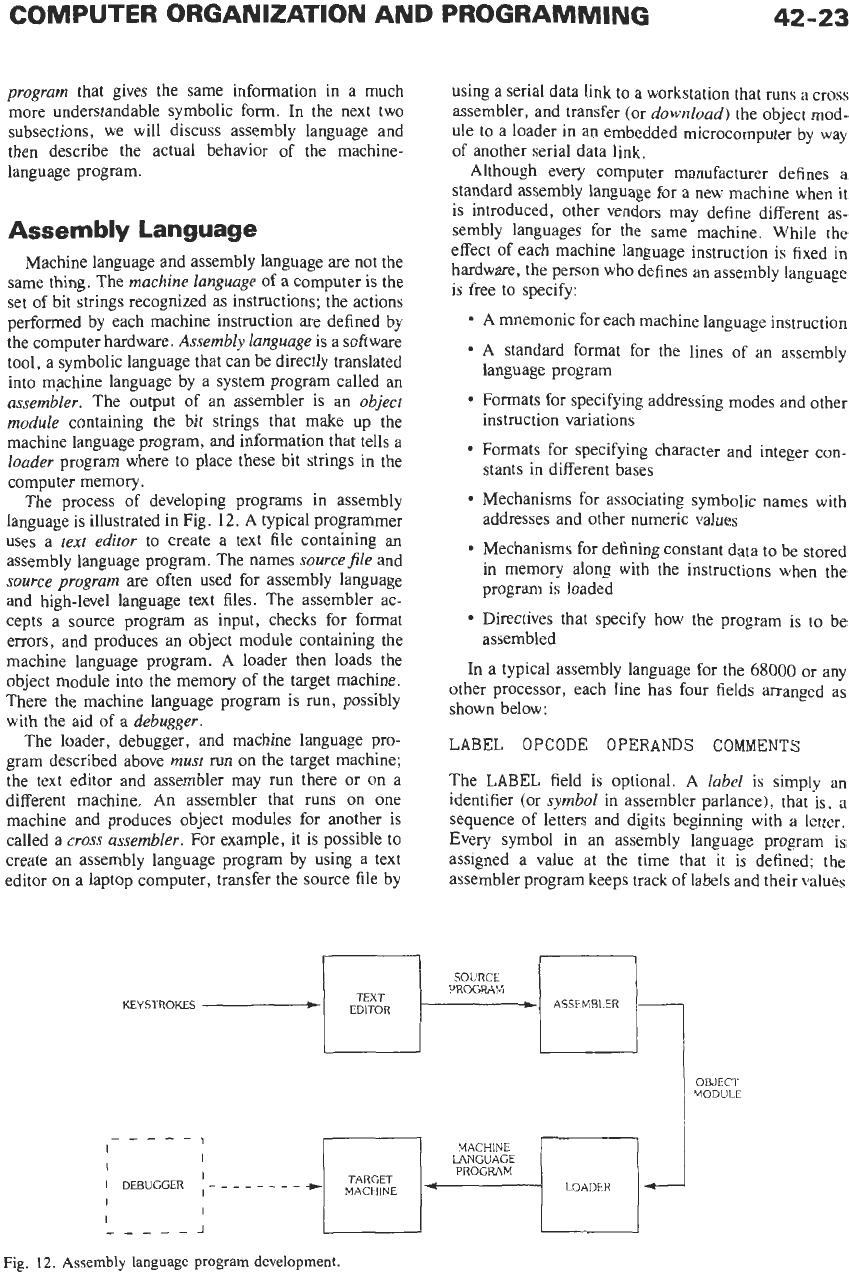
COMPUTER ORGANIZATION AND PROGRAMMING
42-23
program
that gives the same information in a much
more understandable symbolic form. In the next two
subsections, we will discuss assembly language and
then describe the actual behavior of the machine-
language program.
Assembly Language
Machine language and assembly language are not the
same thing. The
machine language
of a computer is the
set of bit strings recognized as instructions; the actions
performed by each machine instruction are defined by
the computer hardware.
Assembly language
is a software
tool, a symbolic language that can be directly translated
into machine language by a system program called an
assembler.
The output
of
an assembler is an
object
module
containing the bit strings that make up the
machine language program, and information that tells a
loader
program where to place these bit strings in the
computer memory.
The process of developing programs in assembly
language is illustrated in Fig.
12.
A
typical programmer
uses a
text editor
to create a text file containing an
assembly language program. The names
sourceJile
and
source program
are often used for assembly language
and high-level language text files. The assembler ac-
cepts a source program as input, checks for format
errors, and produces an object module containing the
machine language program. A loader then loads the
object module into the memory of the target machine.
There the machine language program is run, possibly
with the aid of a
debugger.
The loader, debugger, and machine language pro-
gram described above
must
run on the target machine;
the text editor and assembler may run there or on a
different machine.
An
assembler that runs on one
machine and produces object modules for another is
called a
cross assembler.
For example, it is possible to
create an assembly language program by using a text
editor on a laptop computer, transfer the source file by
using a serial data link to a workstation that runs a cross
assembler, and transfer (or
download)
the object mod-
ule to a loader in an embedded microcomputer by way
of another serial data link.
Although every computer manufacturer defines a
standard assembly language for a new machine when
it
is introduced, other vendors may define different as-
sembly languages for the same machine. While the
effect
of
each machine language instruction
is
fixed
in
hardware, the person who defines an assembly language
is free to specify:
A mnemonic for each machine language instruction
A
standard format for the lines of an assembly
language program
Formats for specifying addressing modes and other
instruction variations
Formats for specifying character and integer con-
stants in different bases
Mechanisms for associating symbolic names with
addresses and other numeric values
Mechanisms for defining constant data to be stored
in memory along with the instructions when the
program is loaded
Directives that specify how the program is to be
assembled
In a typical assembly language for the
68000
or any
other processor, each line has four fields arranged as
shown below:
LABEL
OPCODE
OPERANDS
COMMENTS
The
LABEL
field is optional.
A
label
is
simply an
identifier (or
symbol
in assembler parlance), that is,
a
sequence of letters and digits beginning with a letter.
Every symbol in an assembly language program is
assigned a value at the time that it is defined; the
assembler program keeps track of labels and their values
KEYSTROKES ASSEMBLER
OBJECT
MODULE
I
I
I
DEBUGGER
I
-
- - -
-
-
-
-
I
I
I
-----A
I
Fi-
GEE
Fi
J
___--
MACHINE
Fig.
12.
Assembly language program development.
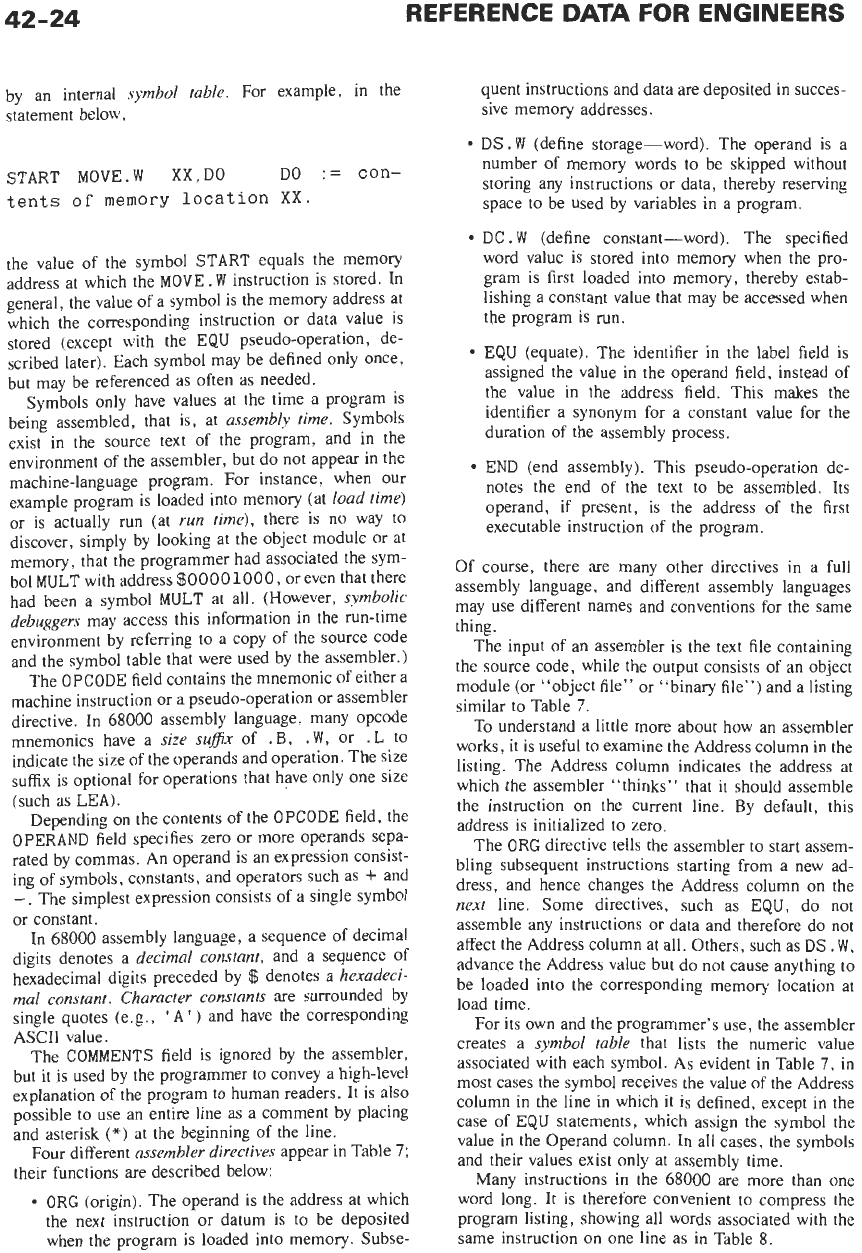
REFERENCE
DATA
FOR ENGINEERS
by an internal
symbol table.
For example, in the
statement below,
START M0VE.W
XX,DO
DO
:=
con-
tents
of
memory location
XX.
the value of the symbol START equals the memory
address at which the
MOVE.
W
instruction is stored. In
general, the value of a symbol is the memory address at
which the corresponding instruction or data value is
stored (except with the EQU pseudo-operation, de-
scribed later). Each symbol may be defined only once,
but may be referenced as often as needed.
Symbols only have values at the time a program is
being assembled, that is, at
assembly time.
Symbols
exist in the source text of the program, and in the
environment
of
the assembler, but do not appear in the
machine-language program. For instance, when our
example program is loaded into memory (at
load time)
or
is actually run (at
run time),
there is no way to
discover, simply by looking at the object module or at
memory, that the programmer had associated the sym-
bo1 MULT with address
$00001000,
or
even that there
had been a symbol MULT at all. (However,
symbolic
debuggers
may access this information in the run-time
environment by referring to a copy of the source code
and the symbol table that were used by the assembler.)
The OPCODE field contains the mnemonic
of
either a
machine instruction or a pseudo-operation or assembler
directive. In
68000
assembly language, many opcode
mnemonics have a
size
SUB
of
.B,
.
W,
or
.L
to
indicate the size of the operands and operation. The size
suffix
is
optional for operations that have only one size
(such as
LEA).
Depending on the contents
of
the OPCODE field, the
OPERAND field specifies zero or more operands sepa-
rated by commas. An operand is an expression consist-
ing
of
symbols, constants, and operators such as
+
and
-.
The simplest expression consists
of
a single symbol
or constant.
In
68000
assembly language, a sequence of decimal
digits denotes a
decimal constant,
and a sequence
of
hexadecimal digits preceded by
$
denotes a
hexadeci-
mal constant. Character constants
are surrounded by
single quotes (e.g.,
A
’
)
and have the corresponding
ASCII value.
The COMMENTS field is ignored by the assembler,
but it is used by the programmer to convey a high-level
explanation of the program to human readers. It is also
possible to use an entire line as a comment
by
placing
and asterisk
(*)
at the beginning of the line.
Four different
assembler directives
appear in Table
7;
their functions are described below:
*
ORG
(origin). The operand is the address at which
the next instruction or datum is to be deposited
when the program
is
loaded into memory. Subse-
quent instructions and data are deposited in succes-
sive memory addresses.
DS
.
W
(define storage-word). The operand is a
number of memory words to be skipped without
storing any instructions or data, thereby reserving
space to be used by variables in a program.
DC
.
W
(define constant-word). The specified
word value is stored into memory when the pro-
gram is first loaded into memory, thereby estab-
lishing a constant value that may be accessed when
the program is run.
EQU
(equate). The identifier in the label field
is
assigned the value in the operand field, instead
of
the value in the address field. This makes the
identifier a synonym for a constant value for the
duration of the assembly process.
END (end assembly). This pseudo-operation de-
notes the end of the text to be assembled. Its
operand, if present, is the address
of
the first
executable instruction of the program.
Of course, there are many other directives
in
a
full
assembly language, and different assembly languages
may use different names and conventions for the same
thing.
The input of an assembler is the text file containing
the source code, while the output consists of an object
module (or “object file” or “binary file”) and a listing
similar to Table
7.
To understand a little more about how an assembler
works, it is useful to examine the Address column in the
listing. The Address column indicates the address at
which the assembler “thinks” that it should assemble
the instruction on the current line. By default, this
address is initialized to zero.
The
ORG
directive tells the assembler to start assem-
bling subsequent instructions starting from a new ad-
dress, and hence changes the Address column on the
next
line. Some directives, such as EQU, do not
assemble any instructions or data and therefore do not
affect the Address column at all. Others, such as
DS
.
W,
advance the Address value but do not cause anything to
be loaded into the corresponding memory location at
load time.
For its own and the programmer’s use, the assembler
creates a
symbol table
that lists the numeric value
associated with each symbol. As evident in Table
7,
in
most cases the symbol receives the value of the Address
column in the line in which
it
is defined, except
in
the
case of EQU statements, which assign the symbol the
value in the Operand column. In all cases, the symbols
and their values exist only at assembly time.
Many instructions in the
68000
are more than one
word long. It is therefore convenient to compress the
program listing, showing all words associated with the
same instruction on one line as in Table
8.
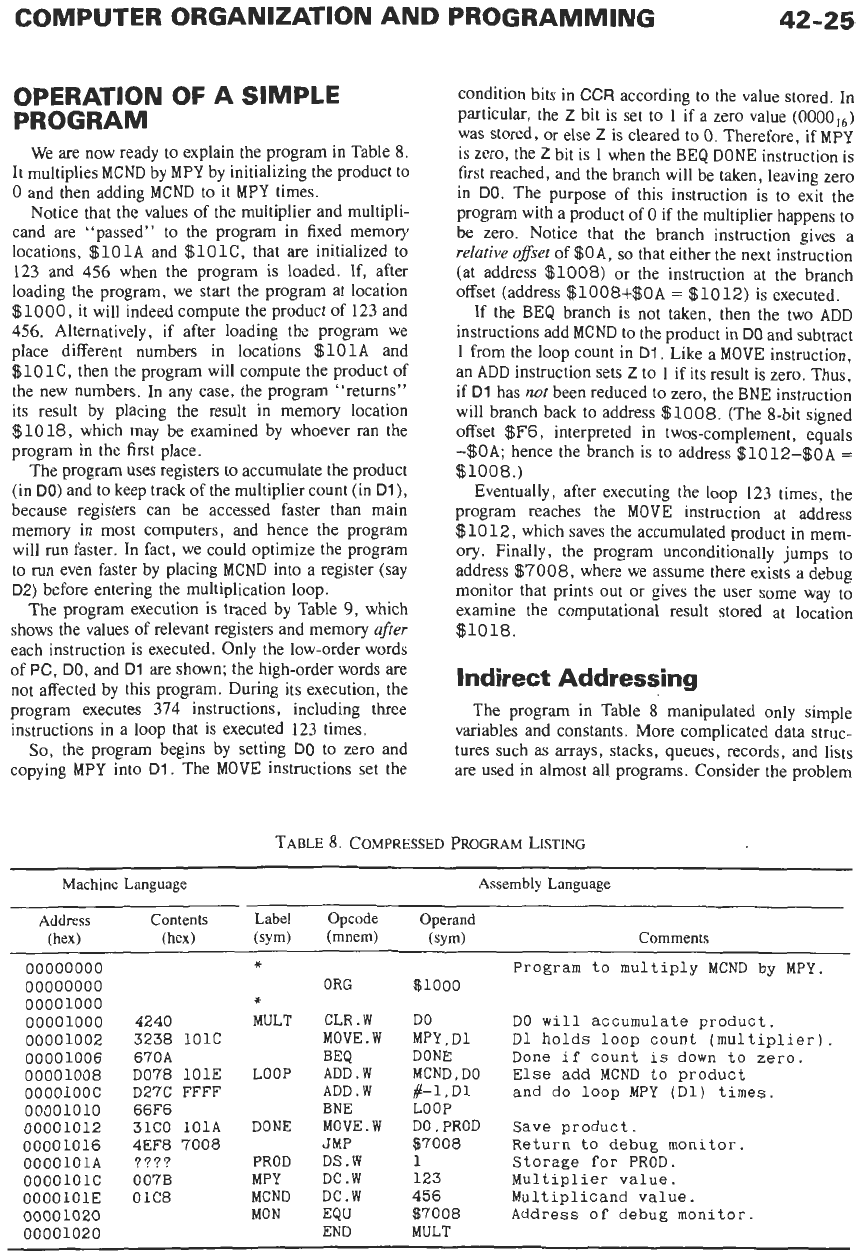
OPERATION
OF
A
SIMPLE
PROGRAM
We are now ready to explain the program in Table 8.
It multiplies
MCND
by
MPY
by initializing the product to
0
and then adding
MCND
to it
MPY
times.
Notice that the values of the multiplier and multipli-
cand are “passed” to the program in fixed memory
locations,
$101A
and
$101C,
that are initialized to
123 and 456 when the program is loaded. If, after
loading the program, we start the program at location
$1000,
it will indeed compute the product of 123 and
456.
Alternatively, if after loading the program we
place different numbers in locations
$101A
and
$10
1
C,
then the program will compute the product of
the new numbers. In any case, the program “returns”
its result by placing the result in memory location
$1018,
which may be examined by whoever ran the
program in the first place.
The program uses registers to accumulate the product
(in
DO)
and to keep track of the multiplier count (in
D1
j,
because registers can be accessed faster than main
memory in most computers, and hence the program
will run faster. In fact, we could optimize the program
to run even faster by placing
MCND
into a register (say
D2)
before entering the multiplication loop.
The program execution
is
traced by Table
9,
which
shows the values
of
relevant registers and memory
after
each instruction is executed. Only the low-order words
of
PC,
DO,
and
D1
are shown; the high-order words are
not affected by this program. During its execution, the
program executes 374 instructions, including three
instructions in a loop that is executed 123 times.
So,
the program begins by setting
DO
to zero and
copying
MPY
into
D1.
The
MOVE
instructions set the
condition bits in
CCR
according to the value stored. In
particular, the
Z
bit is set to 1 if a zero value
(0000,,)
was stored, or else
2
is cleared to
0.
Therefore,
if
MPY
is zero, the
Z
bit is 1 when the
BE&
DONE
instruction is
first reached, and the branch will be taken, leaving zero
in
DO.
The purpose of this instruction
is
to
exit the
program with a product of
0
if the multiplier happens to
be zero. Notice that the branch instruction gives a
relative
oflsset
of
$OA,
so
that either the next instruction
(at address
$1008)
or the instruction at the branch
offset (address
$1008+$OA
=
$1012)
is executed.
If the
BEQ
branch
is
not taken, then the two
ADD
instructions add
MCND
to the product in
DO
and subtract
1 from the loop count in
D1.
Like a
MOVE
instruction,
an
ADD
instruction sets
2
to
1 if
its
result is zero. Thus,
if
D1
has
not
been reduced to zero, the
BNE
instruction
will branch back to address
$1008.
(The 8-bit signed
offset
$F6,
interpreted in twos-complement, equals
-$OA;
hence the branch is to address
$1012-$OA
=
$1008.)
Eventually, after executing the loop 123 times, the
program reaches the
MOVE
instruction at address
$10
12,
which saves the accumulated product in mem-
ory. Finally, the program unconditionally jumps to
address
$7008,
where we assume there exists a debug
monitor that prints out or gives the user some way to
examine the computational result stored at location
$1018.
Indirect Addressing
The program in Table
8
manipulated only simple
variables and constants. More complicated data struc-
tures such as arrays, stacks, queues, records, and lists
are used in almost all programs. Consider the problem
TABLE 8. COMPRESSED PROGRAM
LISTING
Machine Language Assembly Language
Address Contents Label Opcode Operand
(hex) (hex) (sym) (mnem) (sym) Comments
*
00000000
Program to multiply MCND by MPY.
00001000
00001000
4240
MULT CLR.W DO DO will accumulate product.
00001002 3238 lOlC M0VE.W MPY,Dl D1 holds loop count (multiplier).
00001006 670A BE4 DONE
Done
if
count is down to zero.
00001008 DO78 lOlE
LOOP
ADD.W MCND,DO Else add MCND to product
~OOOlOOC D27C FFFF ADD.W #-1,Dl and do loop MPY (Dl) times.
00001012
31120 lOlA DONE M0VE.W D0,PROD Save product.
00001016 4EF8
7008
JMP
$70
0
8
Return to debug monitor.
OOOOlOlA
????
PROD
DS.W
1
Storage
for
PROD.
OOOOlOlC
007B
MPY
DC.W 123 Multiplier value.
OOOOlOlE 01C8 MCND DC.W 456 Multiplicand value.
00001020 MON EQU $7008 Address of debug monitor.
00001020 END MULT
00000000
ORG
$1000
*
00001010
66F6 BNE LOOP
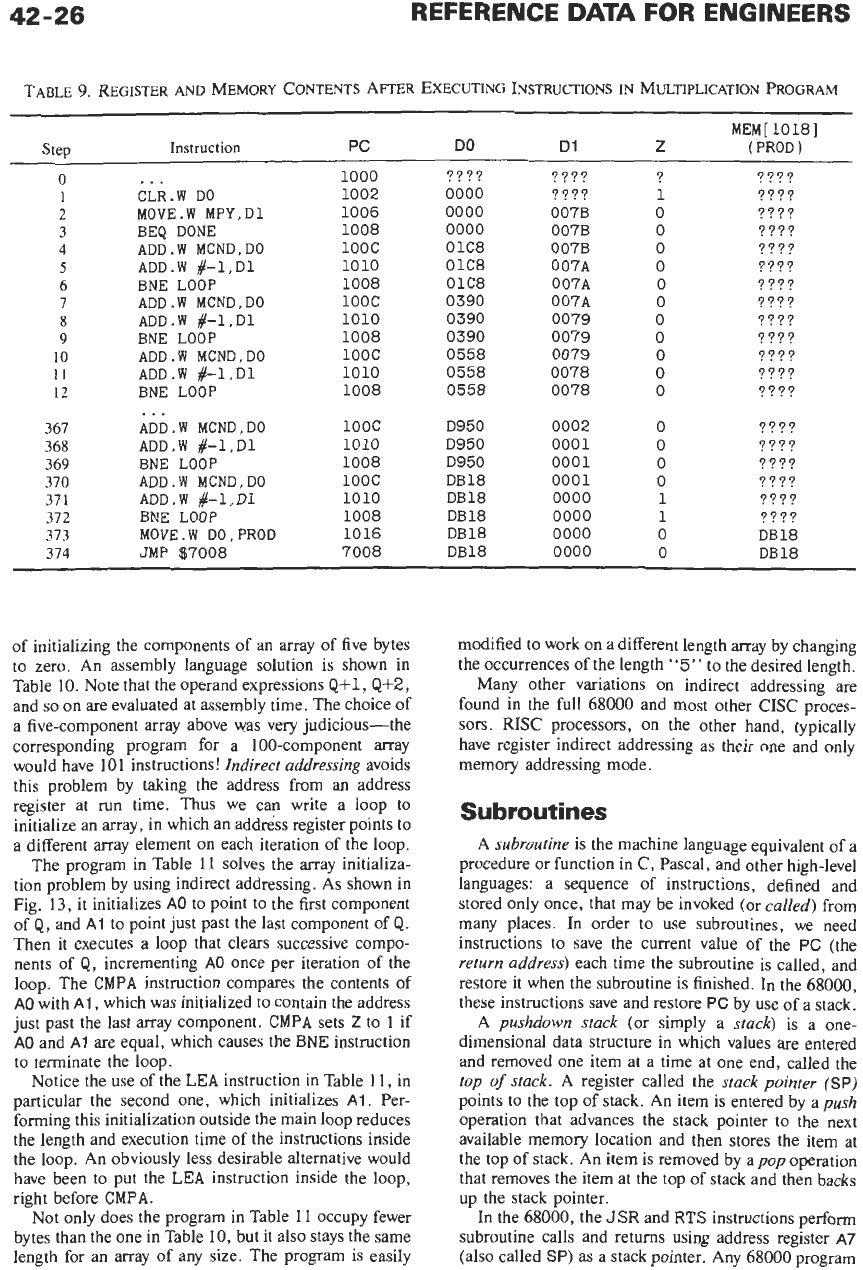
REFERENCE
DATA
FOR ENGINEERS
TABLE
9.
REGISTER
AND
MEMORY CONTENTS AFTER EXECUTING INSTRUCTIONS
IN
MULTIPLICATION PROGRAM
MEM[1018]
Step Instruction
PC
DO
D1
Z
(
PROD
)
...
1000
????
????
?
????
1
CLR.W DO
1002
0000
????
1
????
2
M0VE.W MPY,Dl
1006
0000
007B
0
????
3
BEQ DONE 1008
0000
007B
0
????
4 ADD.W MCND,DO l0OC 01C8 007B
0
????
5
ADD.W #-1,D1
1010
01C8 007A
0
????
6
BNE LOOP 1008 01C8 007A
0
????
7
ADD.W MCND,DO l0OC 0390 007A
0
????
8
ADD.W
#-l.Dl
1010
0390 0079
0
????
9
BNE LOOP 1008 0390 0079
0
????
10
ADD.W MCND,DO l0OC 0558 0079
0
????
11
ADD.W #-l,Dl
1010
0558 0078
0
????
12
BNE LOOP 1008 0558 0078
0
????
0
367
368
369
370
37
1
312
313
314
...
ADD.W MCND,DO
ADD.W
#-1,D1
BNE LOOP
ADD.W MCND,DO
ADD.W #-l,D1
BNE LOOP
MOVE.
W
DO, PROD
JMP $7008
l0OC
1010
1008
l0OC
1010
1008
1016
7008
D950
D950
D950
DB
18
DB18
DB18
DB18
DB18
0002
0001
0001
0001
0000
0000
0000
0000
0
????
0
????
0
????
0
????
1
????
1
????
0
DB18
0
DB18
Subroutines
of initializing the components of an array
of
five bytes
to zero. An assembly language solution is shown in
Table
10.
Note that the operand expressions
Q+l,
Q+2,
and
so
on
are evaluated at assembly time. The choice
of
a five-component array above was very judicious-the
corresponding program for a 100-component array
would have
101
instructions!
Indirect addressing
avoids
this problem by taking the address from
an
address
register at
run
time. Thus we can write a loop to
initialize an array, in which an address register points to
a different array element
on
each iteration of the loop.
The program in Table
11
solves the array initializa-
tion problem by using indirect addressing. As shown in
Fig.
13,
it initializes
A0
to point to the first component
of
Q,
and
A1
to point just past the last component of
Q.
Then it executes a loop that clears successive compo-
nents of
Q,
incrementing
A0
once per iteration of the
loop. The CMPA instruction compares the contents
of
A0
with
A1
,
which was initialized to contain the address
just past the last array component. CMPA sets
Z
to
1
if
A0
and
A1
are equal, which causes the BNE instruction
to terminate the loop.
Notice the use of the LEA instruction in Table 11, in
particular the second one, which initializes
Al.
Per-
forming this initialization outside the main
loop
reduces
the length and execution time of the instructions inside
the loop. An obviously less desirable alternative would
have been to put the LEA instruction inside the loop,
right before CMPA.
Not
only does the program in Table
11
occupy fewer
bytes than the one in Table
10,
but it also stays the same
length for an array of any size. The program is easily
modified to work
on
a different length array by changing
the occurrences of the length
“5”
to the desired length.
Many other variations
on
indirect addressing are
found in the full 68000 and most other CISC proces-
sors.
RISC
processors,
on
the other hand, typically
have register indirect addressing as their one and only
memory addressing mode.
A
subroutine
is the machine language equivalent of a
procedure or function in C, Pascal, and other high-level
languages: a sequence of instructions, defined and
stored only once, that may be invoked (or
called)
from
many places.
In
order to use subroutines, we need
instructions to save the current value of the
PC
(the
return address)
each time the subroutine is called, and
restore it when the subroutine is finished.
In
the 68000,
these instructions save and restore
PC
by use of a stack.
A
pushdown stack
(or simply a
stack)
is a one-
dimensional data structure in which values are entered
and removed one item at a time at one end, called the
top
of
stack.
A
register called the
stack pointer
(SP)
points to the top of stack. An item is entered by a
push
operation that advances the stack pointer to the next
available memory location and then stores the item at
the top of stack. An item is removed by a
pop
operation
that removes the item at the top
of
stack and then backs
up the stack pointer.
In
the 68000, the
JSR
and
RTS
instructions perform
subroutine calls and returns using address register
A7
(also called
SP)
as a stack pointer. Any 68000 program
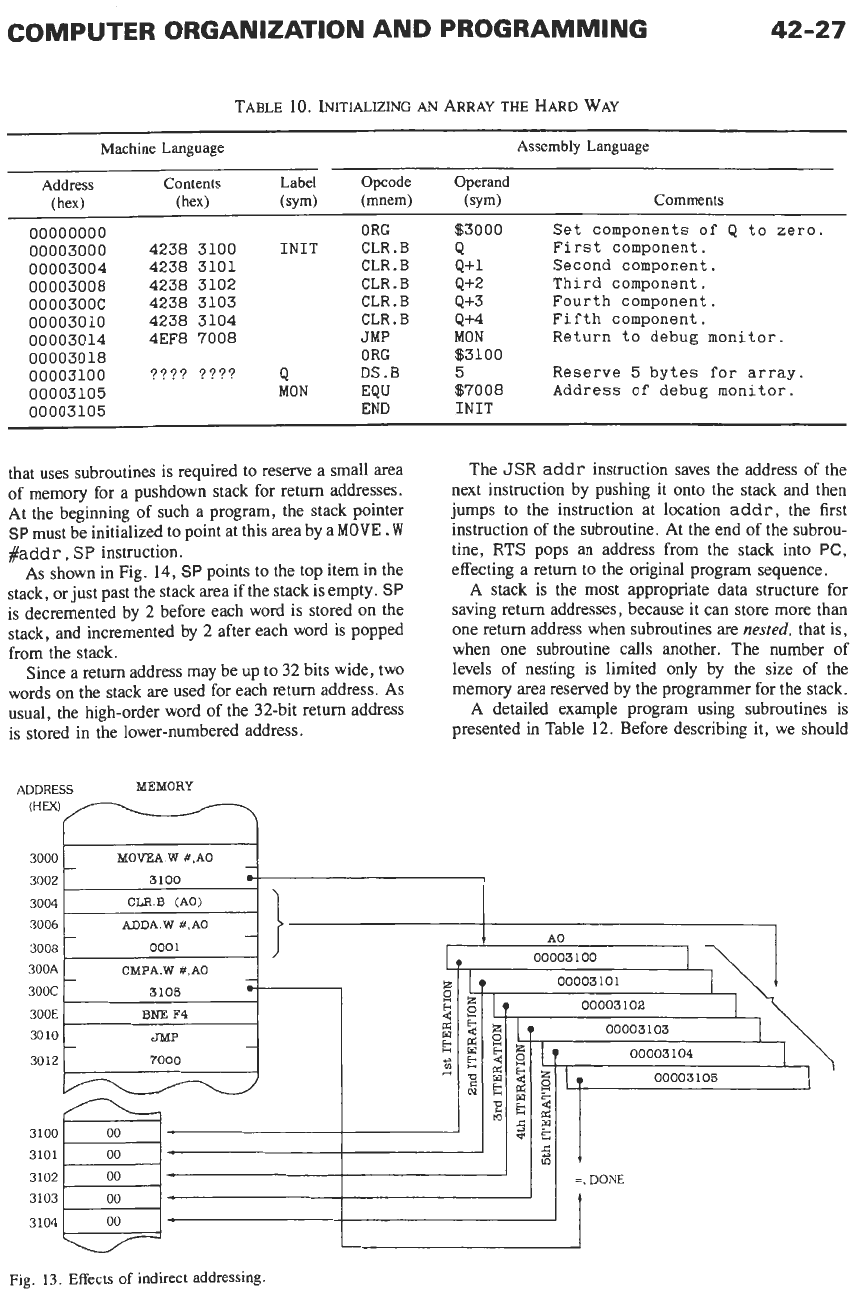
42-27
3002
3004
3006
3008
TABLE
10.
mITIALIZING
AN
ARRAY
THE
HARD
WAY
3100
*.
-
I
-1
A0
-
CLR.B
(AO)
0DA.W #,A0
0001
~~
Machine Language Assembly Language
Address Contents Label Opcode Operand
(hex) (hex) (sym) (mnem) (sym) Comments
00000000
ORG
$3000
Set
components of
Q
to zero.
00003000 4238 3100
INIT
CLR.B
Q
First
component.
00003004 4238
3101
CLR.B
Q+1 Second component.
00003008 4238 3102
CLR.B
Q+2 Third component.
0000300C
4238 3103
CLR.B
Q+3 Fourth component.
00003010 4238 3104
CLR.B
Q+4 Fifth component.
00003014 4EF8 7008
JMP
MON
Return to debug monitor.
00003018
ORG
$3100
00003100
????
????
Q
DS.B
5
Reserve
5
bytes for
array.
00003105
MON
EQU
$7008
Address
of
debug monitor.
00003105
END
INIT
z
8
2
w
P
N
E
that uses subroutines is required to reserve a small area
of memory for a pushdown stack for return addresses.
At the beginning of such a program, the stack pointer
SP
must be initialized to point at this area by a
MOVE
.
W
#addr
,
SP
instruction.
As shown in Fig.
14,
SP
points to the top item in the
stack, or just past the stack area if the stack is empty.
SP
is decremented by 2 before each word is stored on the
stack, and incremented by 2 after each word is popped
from the stack.
Since a return address may be up to 32 bits wide, two
words on the stack
are
used for each return address. As
usual, the high-order word of the 32-bit return address
is stored in the lower-numbered address.
ADDRESS
MEMORY
The
JSR
addr
instruction saves the address of the
next instruction by pushing it onto the stack and then
jumps to the instruction at location
addr,
the first
instruction of the subroutine. At the end of the subrou-
tine,
RTS
pops an address from the stack into
PC,
effecting a return to the original program sequence.
A stack is the most appropriate data structure for
saving return addresses, because it can store more than
one return address when subroutines are
nested,
that is,
when one subroutine calls another. The number of
levels of nesting is limited only by the size of the
memory area reserved by the programmer for the stack.
A detailed example program using subroutines is
presented in Table 12. Before describing it, we should
CMPA.W #,A0
BNE
F4
3010
3012
L
8
2
E
L1
v)
r(
3100
0
00003 102
00003103
00003 104
00003105
3101B;;
I
121
;
3102
=,
DONE
3103
3104
Fig.
13.
Effects
of
indirect addressing.
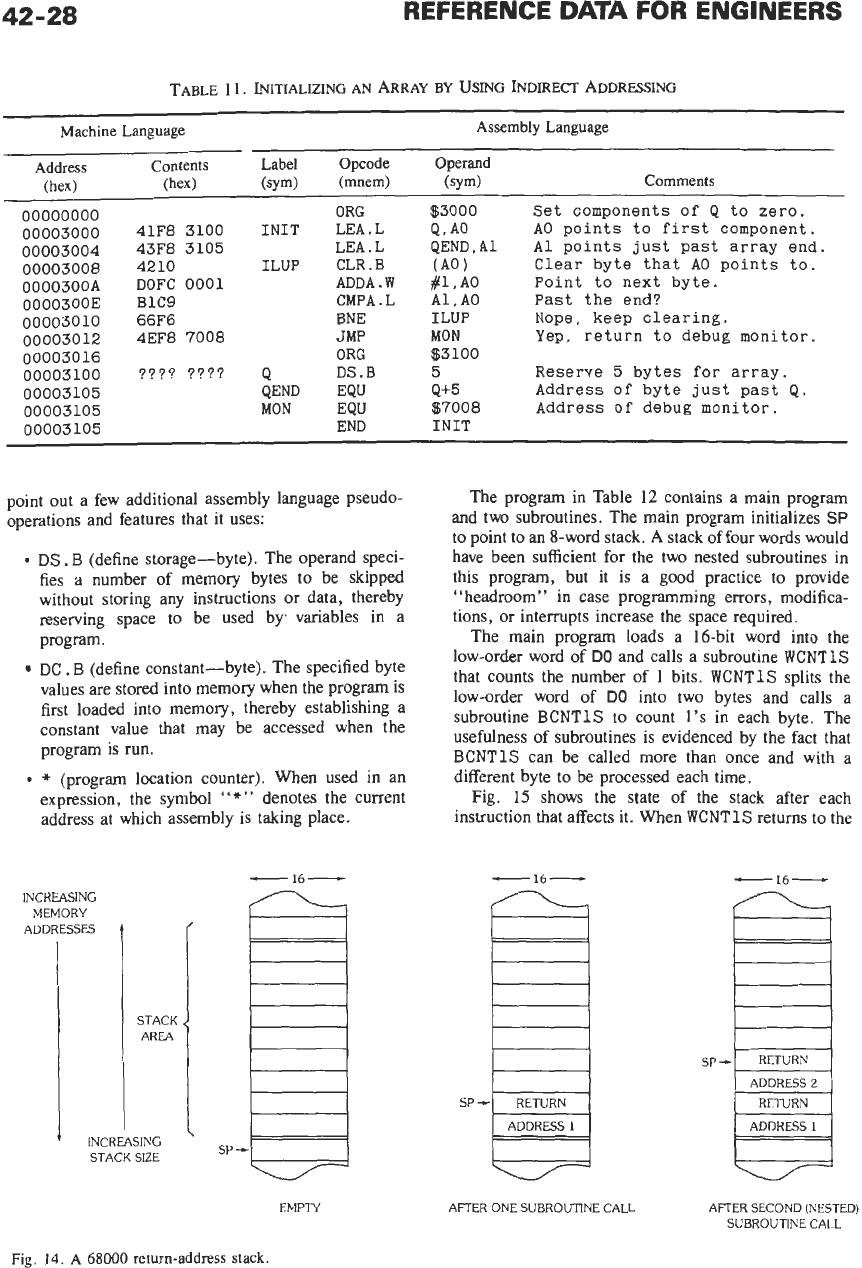
42-28
TABLE
1 1.
INITIALIZING
AN
ARRAY
BY
USING
INDIRECT ADDRESSING
Machine Language Assembly Language
Address Contents Label Opcode Operand
(hex) (sym) (mnem)
(vm)
Comments
(hex)
00000000
ORG
$3000 Set components
of
Q
to zero.
00003000
41F8
3100
INIT
LEA.L
Q,AO
A0
points to
first
component.
00003004 43F8
3105
LEA.L
QEND,Al
A1
points just past
array
end.
00003008
4210
ILUP
CLR.B
(AO)
Clear
byte
that
A0 points to.
0000300A DOFC 0001
ADDA.W
#1,AO
Point to next byte.
0000300E
B1C9
CMPA.L
A1,AO
Past the end?
00003010 66F6
BNE
ILUP
Nope, keep clearing.
00003012 4EF8 7008 JMP
MON
Yep,
return to debug monitor.
00003016
ORG
$3100
00003100
????
????
Q
DS.B
5
Reserve
5
bytes
for
array.
00003105
QEND
EQU
Q+5
Address
of
byte just past
Q.
00003105
MON
EQU
$7008 Address
of
debug monitor.
00003105
END
INIT
point out a few additional assembly language pseudo-
operations and features that it uses:
*
DS
.
B
(define storage-byte). The operand speci-
fies a number of memory bytes to be skipped
without storing any instructions or data, thereby
reserving space to be used by. variables in a
program.
DC
.
B
(define constant-byte). The specified byte
values are stored into memory when the program is
first loaded into memory, thereby establishing a
constant value that may be accessed when the
program
is
run.
*
*
(program location counter). When used in an
expression, the symbol
“I”
denotes the current
address at which assembly is taking place.
INCREASING
MEMORY
STACK SIZE
I
SP
-
H
The program in Table
12
contains a main program
and two subroutines. The main program initializes
SP
to point to an 8-word stack. A stack
of
four words would
have been sufficient for the two nested subroutines in
this program, but it is a good practice to provide
“headroom” in case programming errors, modifica-
tions, or interrupts increase the space required.
The main program loads a 16-bit word into the
low-order word
of
DO
and calls a subroutine
WCNTlS
that counts the number
of
1 bits.
WCNTlS
splits the
low-order word of
DO
into two bytes and calls a
subroutine
BCNTlS
to count
1’s
in each byte. The
usefulness of subroutines is evidenced by the fact that
BCNTlS
can be called more than once and with a
different byte to be processed each time.
Fig.
15
shows the state
of
the stack after each
instruction that affects it. When
WCNTlS
returns to the
-16-
a
H
SP-
H
RETURN
-16-
H
SP-
w
RETURN
EMPTY
Fig.
14.
A
68000
return-address stack.
AFrER ONE SUBROUTINE CALL
AFTER SECOND (NESTED)
SUBROUTINE CALL
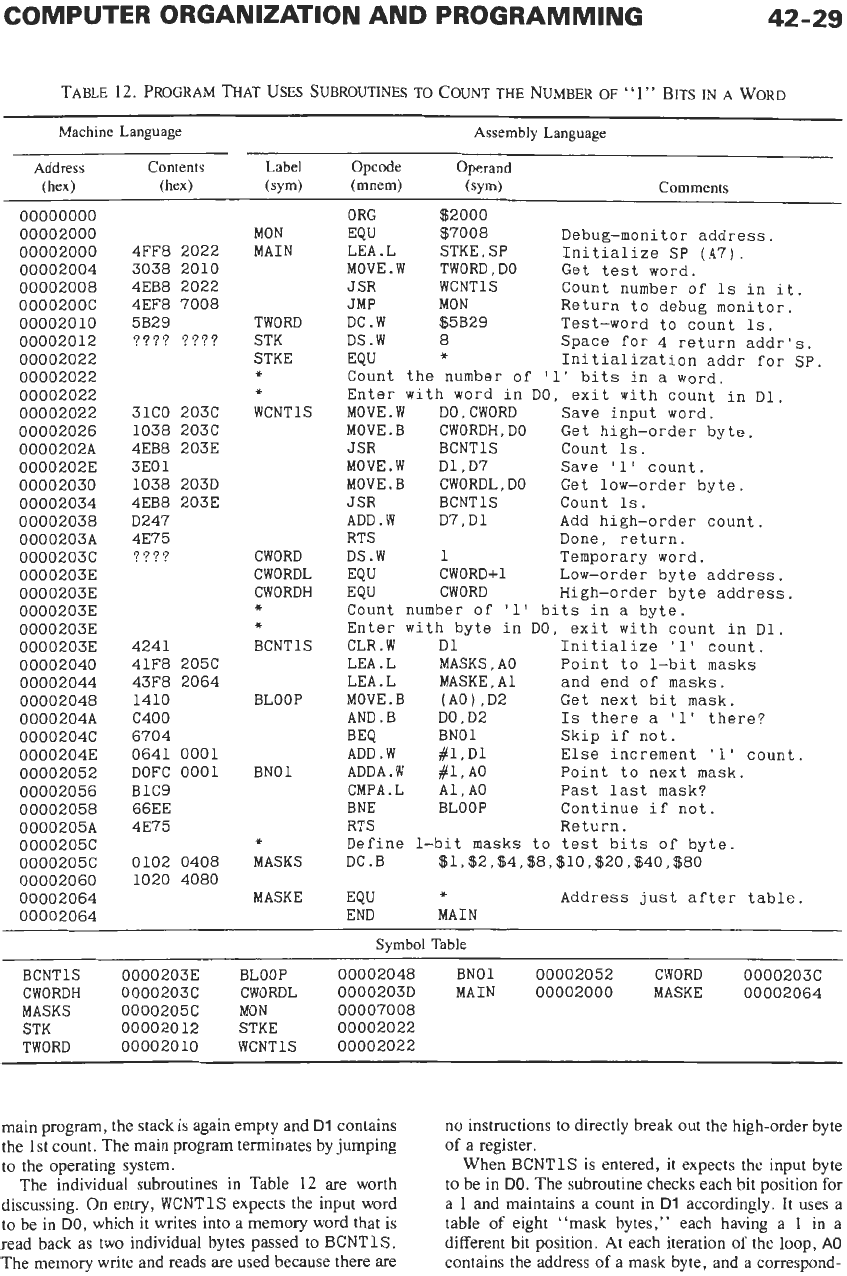
TABLE
12.
PROGRAM THAT
USES
SUBROUTINES
TO
COUNT
THE
NUMBER
OF
“1”
BITS
IN
A
WORD
Machine Language Assembly Language
Address Contents Label Opcode Operand
(hex) (hex)
(sw) (mnem)
(sym) Comments
00000000
00002000
00002000
00002004
00002008
0000200c
00002010
00002012
00002022
00002022
00002022
00002022
00002026
0000202A
0000202E
00002030
00002034
00002038
0000203A
0000203C
0000203E
0000203E
0000203E
0000203E
0000203E
00002040
00002044
00002048
0000204A
0000204C
0000204E
00002052
00002056
00002058
0000205A
0000205C
0000205C
00002060
00002064
00002064
4FF8 2022
3038 2010
4EB8 2022
4EF8 7008
5B29
????
????
31CO
203C
1038 203C
4EB8 203E
3E0
1
1038 203D
4EB8
203E
D247
4E75
????
4241
41F8 205C
43F8 2064
1410
C400
6704
0641
0001
DOFC 0001
B1C9
66EE
4E75
0102 0408
1020 4080
MON
MAIN
TWORD
STK
STKE
*
*
WCNTlS
CWORD
CWORDL
CWORDH
*
*
BCNTlS
BLOOP
BNOl
*
MASKS
MASKE
ORG
$2000
EQU
$7008 Debug-monitor address.
LEA.
L
STKE, SP Initialize SP
(A7).
M0VE.W
TWORD,DO
Get
test word.
JSR WCNTlS Count number of
1s
in
it.
JMP
MON
Return to debug monitor.
DC.W
$5B29 Test-word to count
Is.
DS.W
8
Space for 4 return addr’s.
EQU
Initialization addr for SP.
Count the number of
‘1’
bits in
a
word,
Enter with word in DO, exit with count in
D1.
M0VE.W D0,CWORD Save input word.
M0VE.B
CWORDH,DO
Get high-order byte.
JSR BCNTlS Count
Is.
MOVE.
W
D1,
D7
Save
‘1‘
count.
M0VE.B CWORDL,DO Get low-order byte.
JSR BCNTlS Count
Is.
ADD.W
D7,Dl
Add high-order count.
RTS
Done, return.
DS.W
1
Temporary word.
EQU
CWORD+l
Low-order byte address.
EQU
CWORD
High-order byte address.
Count number of
‘1’
bits in
a
byte.
Enter with byte in
DO,
exit with count in
D1.
CLR.W
D1
Initialize
‘1’
count.
LEA.L
MASKS,AO Point to 1-bit masks
LEA.L
MASKE,Al and end of masks.
M0VE.B (AO),D2 Get next bit mask.
AND.B
DO,D2
Is
there
a
‘1’
there?
BEQ
BNOl
Skip if not.
ADD.W
#1,D1 Else increment
‘1’
count.
ADDA
.
W
#1,
A0 Point
to
next mask.
CMPA.L
A1,AO Past last mask?
BNE
BLOOP Continue if not.
RTS Return.
Define 1-bit masks to test bits of byte.
DC.B
$1,$2,$4,$8,$l0.$20,$40,$80
EQU
Address just after table.
END
MAIN
*
*
-
Symbol Table
BCNTlS 0000203E
BLOOP
00002048
BNOl
00002052
CWORD
0000203C
CWORDH
0000203C
CWORDL
0000203D
MAIN
00002000 MASKE 00002064
0000205C
MON
00007008
MASKS
00002012 STKE 00002022
STK
TWORD
00002010 WCNTlS 00002022
main program, the stack is again empty and
D1
contains
the 1st count. The main program terminates by jumping
to the operating system.
The individual subroutines in Table
12
are worth
discussing. On entry,
WCNTlS
expects the input word
to be in
DO,
which it writes into a memory word that is
read back as two individual bytes passed to
BCNTlS.
The memory write and reads are used because there are
no instructions to directly break out the high-order byte
of
a register.
When
BCNTlS
is entered,
it
expects the input byte
to be in
DO.
The subroutine checks each bit position for
a
1
and maintains a count in
D1
accordingly.
It
uses a
table
of
eight “mask bytes,” each having
a
1
in a
different bit position. At each iteration
of
the loop,
A0
contains the address
of
a mask byte, and a correspond-
